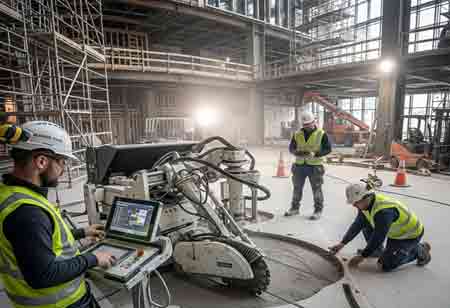Thank you for Subscribing to Construction Business Review Weekly Brief
Specials
- MEP Canada
- Kitchen and Bath
- Decking Canada
- Architectural Glass Europe
- MEP APAC
- Construction Saudi Arabia
- German Apartment and Condominium Contractors
- Construction Law APAC
- Outdoor Construction
- Foundation Construction Canada
- Building Sealing Solutions Europe
- Apartment and Condominium Contractors Canada
- Cold Storage Construction APAC
- Precast Concrete Europe
- Construction Staffing Europe
- Pre-Construction Services
- Flooring System APAC
- Scaffolding Canada
- Swimming Pool Construction Canada
- Construction Management Canada
- Dummy
- Building Restoration and Maintenance Canada
- Residential Construction
- Concrete Canada
- Construction Cladding Europe
- Construction Cladding APAC
- Concretes, Aggregates and Construction Materials APAC
- Concretes, Aggregates and Construction Materials Europe
- Commercial Contractors Europe
- Commercial Contractors APAC
- Cold Storage Construction Canada
- Flooring Systems Europe
- Construction Management APAC
- Landscaping Canada
- Construction Coating Europe
- Construction Tech Startups Europe
- Insulation Services Europe
- Mechanical Contractor Canada
- Mould Remediation and Testing Europe
- Swimming Pool Construction APAC
- Construction Engineering Services
- Mechanical Electrical and Plumbing
- Roofing Systems Europe
- Architectural Glass APAC
- Startups APAC
- Forensic and Owners Representative
- Flooring System
- Waterproofing APAC
- Wall Systems
- Safety and Compliance Europe
- Construction Bidding and Auctions
- Modular and Prefab Construction
- Architectural Glass
- Construction MENA
- Construction Demolition and Recycling Europe
- Modular Construction Europe
- Construction Interiors
- Steel Building APAC
- HVAC
- Doors and windows
- Modular Construction APAC
- Insulation, Coating and Waterproofing
- Building Information Modeling APAC
- Sustainable Construction APAC
- Building Restoration and Maintenance
- Commercial Contractors
- Specialty Construction
- Construction Engineering Canada
- Construction Engineering MENA
- Modular Construction Canada
- Roofing and Siding Systems
- Construction Latam
- Workforce Management and Staffing
- Roofing Systems APAC
- Construction Consulting
- Steel Building Europe
- Construction Demolition and Recycling APAC
- Safety and Compliance APAC
- Concretes, Aggregates and Materials
- Construction Cladding
Concrete Cutting as a Strategic Contributor to Construction Success
The concrete cutting industry has evolved into a precision-driven discipline, essential for the successful execution of modern construction's complex projects, emphasizing specialized expertise and advanced technology.

By
Construction Business Review | Friday, August 08, 2025
Stay ahead of the industry with exclusive feature stories on the top companies, expert insights and the latest news delivered straight to your inbox. Subscribe today.
Modern construction is experiencing a paradigm shift toward specialization, driven by increasingly complex projects that have elevated subcontractors from support roles to critical collaborators. Among these, the concrete cutting industry has undergone significant evolution, transitioning from basic demolition to a precision-focused discipline essential to contemporary building. This transformation is rooted in the demands of modern architecture, where bold designs and stringent engineering standards require surgical accuracy in modifying concrete structures. As buildings integrate intricate systems for utilities, data, and mechanical functions, concrete cutting now plays a vital role in enabling precise alterations without compromising structural integrity.
From Demolition to Precision Engineering
The evolution of the concrete cutting trade into a discipline of precision engineering signifies a pivotal moment in its historical trajectory. This transformation is driven by the fundamental imperatives of contemporary construction, wherein structures are designed for optimal functionality, efficiency, and adaptability. The primary objective has shifted from mere concrete disaggregation to the surgical modification of concrete elements, thereby accommodating the intricate networks of systems that characterize modern edifices. This paradigm shift is particularly evident in the integration of specialized contractors into the project lifecycle. They are frequently consulted during the design phase, offering expert insights into the most effective and least disruptive methodologies for creating apertures or modifying concrete components. Their profound understanding of structural dynamics, rebar configurations, and post-tensioning cables is invaluable, facilitating interventions that preserve the integrity of the original design while allowing for necessary alterations. This consultative capacity has redefined their role, transitioning them from a reactive service provider to a proactive partner in the construction process.
The techniques currently employed underscore this progression toward precision. The ubiquitous application of diamond-tipped tooling across all methodologies, ranging from sawing to drilling, ensures immaculate, accurate cuts with minimal spalling or cracking. This degree of control is indispensable for projects that demand stringent tolerances and uncompromising structural integrity. The controlled nature of these processes concurrently contributes to an enhanced work environment, as the risk of uncontrolled collapse or damage to adjacent structures is substantially mitigated. This emphasis on precision has redefined the trade, positioning it as a highly skilled and critical component of complex construction projects, rather than a mere post-construction remediation service.
The Technological Leap: Automation and Digital Integration
The emergence of specialized concrete cutting is inextricably linked to the adoption of advanced technology. This technological advancement has not only enhanced the precision of the work but also significantly improved safety and efficiency. The introduction of remote-controlled, robotic equipment has been transformative. These machines, often powered by hydraulics or electric motors, can be operated remotely, facilitating work in hazardous, confined, or difficult-to-access environments. This capability is particularly critical in demolition or retrofitting projects where structural stability may be compromised or where exposure to dust and noise requires minimization. The automation provided by these robots also ensures greater consistency in the cutting process, leading to more uniform results and a reduction in manual labor fatigue.
Beyond the physical machinery, the industry has made a profound embrace of digital integration. Many specialized subcontractors now utilize Building Information Modeling (BIM) platforms, enabling them to pre-plan every cut, bore, and trench within a virtual environment. This digital modeling offers a comprehensive view of the structure, including the precise location of rebar, post-tensioning cables, and existing utility lines. By integrating with BIM, concrete cutting specialists can identify potential conflicts before any physical cutting commences, ensuring a seamless execution without unforeseen interruptions. This proactive methodology conserves both time and resources, as it obviates the necessity for on-site adjustments and mitigates the risk of damaging critical structural or utility components. The seamless coordination facilitated by digital tools has solidified the specialized concrete cutter's role as a vital contributor to overall project efficiency and success.
Expanding Role in Modern Construction and Infrastructure
The scope of specialized concrete cutting has expanded significantly beyond its traditional applications, establishing itself as an indispensable service across the entire spectrum of contemporary construction and infrastructure projects. In the context of new commercial and residential developments, it facilitates the creation of precise openings for building services, thereby enhancing flexibility in both design and construction sequencing. For instance, following the completion of the main structural pour, a concrete cutting specialist can be engaged to create precise apertures for doors, windows, and MEP (Mechanical, Electrical, and Plumbing) systems, ensuring the meticulous integration of every element. This methodology often proves to be more expeditious and accurate than conventional formwork, which can be susceptible to minor imperfections.
The role of specialized concrete cutters is even more pronounced in extensive renovation and retrofitting endeavors. In such projects, their services constitute the primary means for modifying existing concrete structures to accommodate revised layouts, enlarge open spaces, install new elevators or escalators, or reconfigure stairwells. The capacity to alter these structures without compromising their structural integrity is paramount, and the precision afforded by modern concrete cutting techniques is crucial for achieving this objective. Within the realm of infrastructure, encompassing bridge decks, tunnels, water treatment plants, and power facilities, specialized cutting is employed for a wide array of applications, ranging from creating access points and modifying load-bearing elements to removing damaged sections for repair and replacement. The versatility and adaptability of modern concrete cutting techniques make them a preferred solution for a wide range of applications where speed, precision, and minimal disruption are of paramount importance.
The concrete cutting industry has evolved into a highly skilled, technology-driven trade that is central to the successful execution of intricate construction projects. The demands of modern architecture and engineering have propelled its transformation from a blunt force method to a precision-based science. Their expanding role underscores a fundamental shift in the construction sector toward greater specialization and the inherent value of targeted, expert intervention.





